ACC822 Ethical Issues Relating to Ethical Robots Report
VerifiedAdded on 2023/01/16
|9
|3636
|99
Report
AI Summary
This report, titled "Ethical Issues relating to Ethical Robots: Review and Reflection," addresses the ethical challenges posed by the increasing integration of robots and artificial intelligence in society and business. It begins with an introduction to the field of robot ethics, focusing on potential risks to human beings and the need for careful consideration of ethical implications. The report then delves into a detailed discussion of the ethical problems outlined in the article "The Dark Side of Ethical Robots" by Vanderelst and Winfield (2018), highlighting concerns related to AI advancements and the potential for aggressive or unethical behavior in robots. It explores the risks associated with AI and machine learning, including high investment costs, software malfunctions, AI-human interface challenges, and high expectations. Furthermore, the report discusses the design of ethical robots, emphasizing the importance of gathering information, creating prototypes, and rigorous testing. The report examines ethical issues surrounding robots, such as privacy, security, high intelligence, fake news, misinformation, and AI-related challenges. Finally, the report concludes with a reflection on the societal impact of robots, including their potential to reduce human workload, and the need for ongoing ethical evaluation. The report also references the Care Centred Value Sensitive Design (CCVSD) approach for integrating ethics into robot design. The report aims to provide a comprehensive analysis of the ethical issues relating to robots from a business perspective.
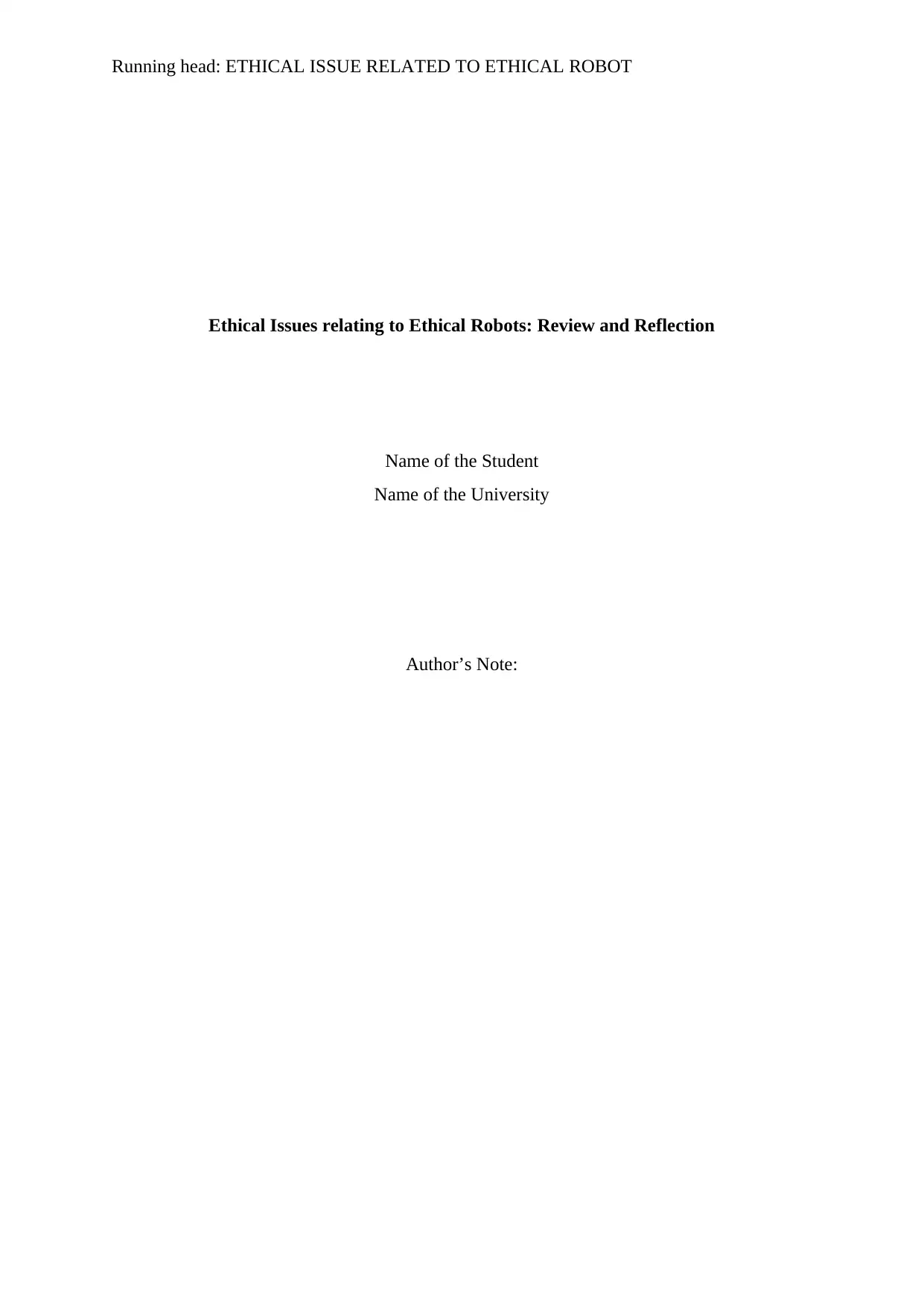
Running head: ETHICAL ISSUE RELATED TO ETHICAL ROBOT
Ethical Issues relating to Ethical Robots: Review and Reflection
Name of the Student
Name of the University
Author’s Note:
Ethical Issues relating to Ethical Robots: Review and Reflection
Name of the Student
Name of the University
Author’s Note:
Paraphrase This Document
Need a fresh take? Get an instant paraphrase of this document with our AI Paraphraser

1
ETHICAL ISSUE RELATED TO ETHICAL ROBOT
Table of Contents
1. Introduction............................................................................................................................2
2. Discussion..............................................................................................................................2
3. Reflection...............................................................................................................................5
4. Conclusion..............................................................................................................................5
References..................................................................................................................................7
ETHICAL ISSUE RELATED TO ETHICAL ROBOT
Table of Contents
1. Introduction............................................................................................................................2
2. Discussion..............................................................................................................................2
3. Reflection...............................................................................................................................5
4. Conclusion..............................................................................................................................5
References..................................................................................................................................7
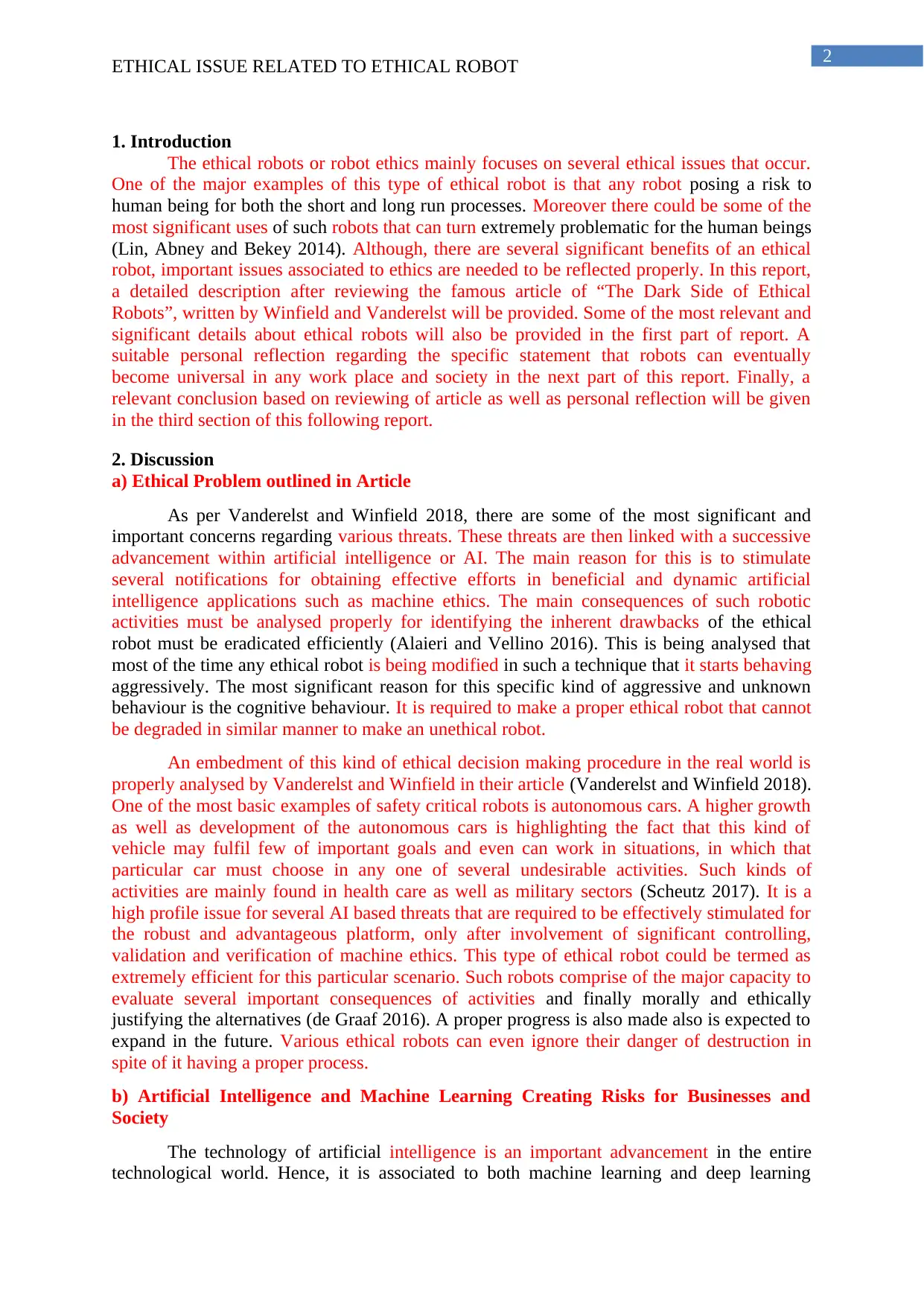
2
ETHICAL ISSUE RELATED TO ETHICAL ROBOT
1. Introduction
The ethical robots or robot ethics mainly focuses on several ethical issues that occur.
One of the major examples of this type of ethical robot is that any robot posing a risk to
human being for both the short and long run processes. Moreover there could be some of the
most significant uses of such robots that can turn extremely problematic for the human beings
(Lin, Abney and Bekey 2014). Although, there are several significant benefits of an ethical
robot, important issues associated to ethics are needed to be reflected properly. In this report,
a detailed description after reviewing the famous article of “The Dark Side of Ethical
Robots”, written by Winfield and Vanderelst will be provided. Some of the most relevant and
significant details about ethical robots will also be provided in the first part of report. A
suitable personal reflection regarding the specific statement that robots can eventually
become universal in any work place and society in the next part of this report. Finally, a
relevant conclusion based on reviewing of article as well as personal reflection will be given
in the third section of this following report.
2. Discussion
a) Ethical Problem outlined in Article
As per Vanderelst and Winfield 2018, there are some of the most significant and
important concerns regarding various threats. These threats are then linked with a successive
advancement within artificial intelligence or AI. The main reason for this is to stimulate
several notifications for obtaining effective efforts in beneficial and dynamic artificial
intelligence applications such as machine ethics. The main consequences of such robotic
activities must be analysed properly for identifying the inherent drawbacks of the ethical
robot must be eradicated efficiently (Alaieri and Vellino 2016). This is being analysed that
most of the time any ethical robot is being modified in such a technique that it starts behaving
aggressively. The most significant reason for this specific kind of aggressive and unknown
behaviour is the cognitive behaviour. It is required to make a proper ethical robot that cannot
be degraded in similar manner to make an unethical robot.
An embedment of this kind of ethical decision making procedure in the real world is
properly analysed by Vanderelst and Winfield in their article (Vanderelst and Winfield 2018).
One of the most basic examples of safety critical robots is autonomous cars. A higher growth
as well as development of the autonomous cars is highlighting the fact that this kind of
vehicle may fulfil few of important goals and even can work in situations, in which that
particular car must choose in any one of several undesirable activities. Such kinds of
activities are mainly found in health care as well as military sectors (Scheutz 2017). It is a
high profile issue for several AI based threats that are required to be effectively stimulated for
the robust and advantageous platform, only after involvement of significant controlling,
validation and verification of machine ethics. This type of ethical robot could be termed as
extremely efficient for this particular scenario. Such robots comprise of the major capacity to
evaluate several important consequences of activities and finally morally and ethically
justifying the alternatives (de Graaf 2016). A proper progress is also made also is expected to
expand in the future. Various ethical robots can even ignore their danger of destruction in
spite of it having a proper process.
b) Artificial Intelligence and Machine Learning Creating Risks for Businesses and
Society
The technology of artificial intelligence is an important advancement in the entire
technological world. Hence, it is associated to both machine learning and deep learning
ETHICAL ISSUE RELATED TO ETHICAL ROBOT
1. Introduction
The ethical robots or robot ethics mainly focuses on several ethical issues that occur.
One of the major examples of this type of ethical robot is that any robot posing a risk to
human being for both the short and long run processes. Moreover there could be some of the
most significant uses of such robots that can turn extremely problematic for the human beings
(Lin, Abney and Bekey 2014). Although, there are several significant benefits of an ethical
robot, important issues associated to ethics are needed to be reflected properly. In this report,
a detailed description after reviewing the famous article of “The Dark Side of Ethical
Robots”, written by Winfield and Vanderelst will be provided. Some of the most relevant and
significant details about ethical robots will also be provided in the first part of report. A
suitable personal reflection regarding the specific statement that robots can eventually
become universal in any work place and society in the next part of this report. Finally, a
relevant conclusion based on reviewing of article as well as personal reflection will be given
in the third section of this following report.
2. Discussion
a) Ethical Problem outlined in Article
As per Vanderelst and Winfield 2018, there are some of the most significant and
important concerns regarding various threats. These threats are then linked with a successive
advancement within artificial intelligence or AI. The main reason for this is to stimulate
several notifications for obtaining effective efforts in beneficial and dynamic artificial
intelligence applications such as machine ethics. The main consequences of such robotic
activities must be analysed properly for identifying the inherent drawbacks of the ethical
robot must be eradicated efficiently (Alaieri and Vellino 2016). This is being analysed that
most of the time any ethical robot is being modified in such a technique that it starts behaving
aggressively. The most significant reason for this specific kind of aggressive and unknown
behaviour is the cognitive behaviour. It is required to make a proper ethical robot that cannot
be degraded in similar manner to make an unethical robot.
An embedment of this kind of ethical decision making procedure in the real world is
properly analysed by Vanderelst and Winfield in their article (Vanderelst and Winfield 2018).
One of the most basic examples of safety critical robots is autonomous cars. A higher growth
as well as development of the autonomous cars is highlighting the fact that this kind of
vehicle may fulfil few of important goals and even can work in situations, in which that
particular car must choose in any one of several undesirable activities. Such kinds of
activities are mainly found in health care as well as military sectors (Scheutz 2017). It is a
high profile issue for several AI based threats that are required to be effectively stimulated for
the robust and advantageous platform, only after involvement of significant controlling,
validation and verification of machine ethics. This type of ethical robot could be termed as
extremely efficient for this particular scenario. Such robots comprise of the major capacity to
evaluate several important consequences of activities and finally morally and ethically
justifying the alternatives (de Graaf 2016). A proper progress is also made also is expected to
expand in the future. Various ethical robots can even ignore their danger of destruction in
spite of it having a proper process.
b) Artificial Intelligence and Machine Learning Creating Risks for Businesses and
Society
The technology of artificial intelligence is an important advancement in the entire
technological world. Hence, it is associated to both machine learning and deep learning
⊘ This is a preview!⊘
Do you want full access?
Subscribe today to unlock all pages.

Trusted by 1+ million students worldwide
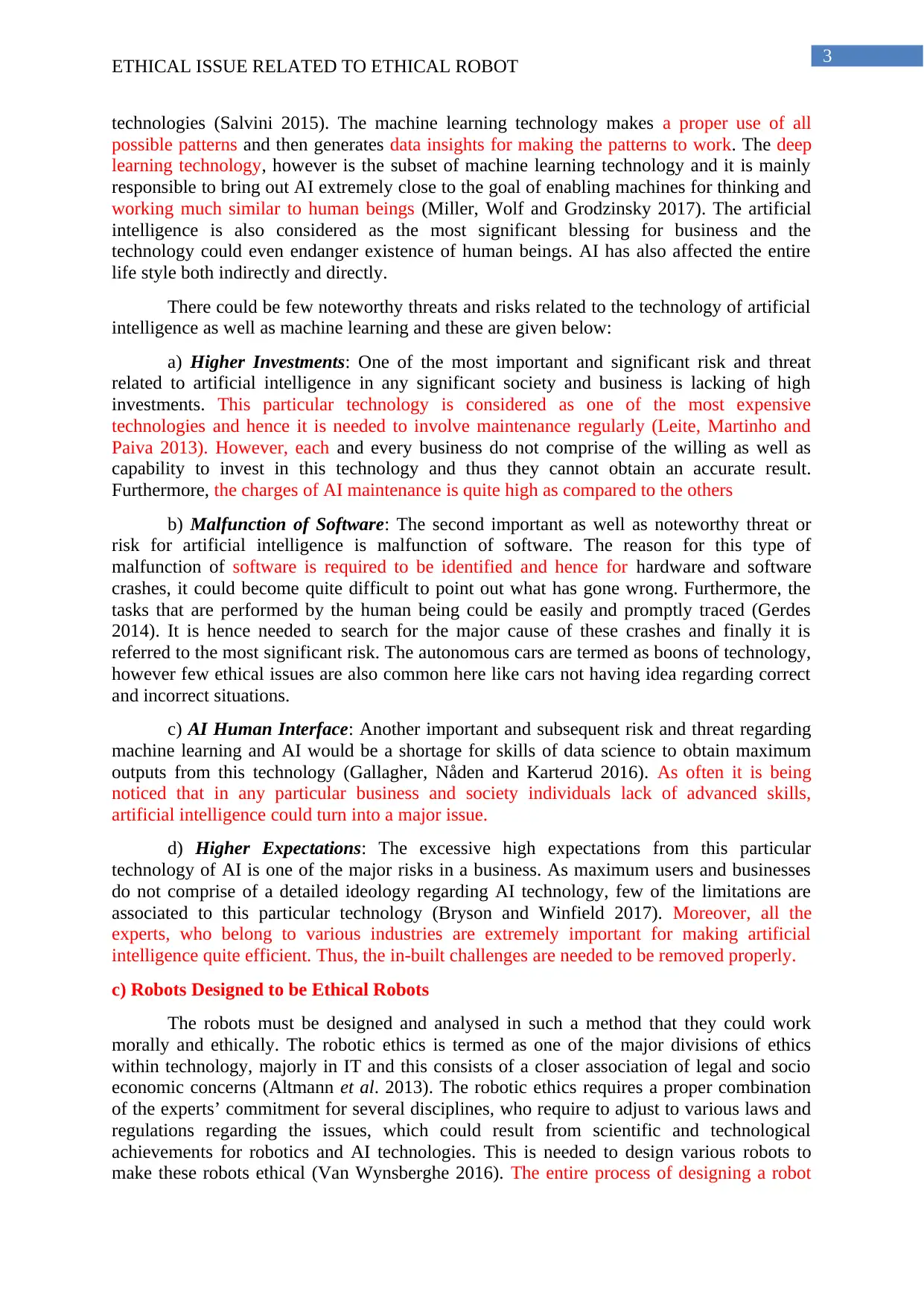
3
ETHICAL ISSUE RELATED TO ETHICAL ROBOT
technologies (Salvini 2015). The machine learning technology makes a proper use of all
possible patterns and then generates data insights for making the patterns to work. The deep
learning technology, however is the subset of machine learning technology and it is mainly
responsible to bring out AI extremely close to the goal of enabling machines for thinking and
working much similar to human beings (Miller, Wolf and Grodzinsky 2017). The artificial
intelligence is also considered as the most significant blessing for business and the
technology could even endanger existence of human beings. AI has also affected the entire
life style both indirectly and directly.
There could be few noteworthy threats and risks related to the technology of artificial
intelligence as well as machine learning and these are given below:
a) Higher Investments: One of the most important and significant risk and threat
related to artificial intelligence in any significant society and business is lacking of high
investments. This particular technology is considered as one of the most expensive
technologies and hence it is needed to involve maintenance regularly (Leite, Martinho and
Paiva 2013). However, each and every business do not comprise of the willing as well as
capability to invest in this technology and thus they cannot obtain an accurate result.
Furthermore, the charges of AI maintenance is quite high as compared to the others
b) Malfunction of Software: The second important as well as noteworthy threat or
risk for artificial intelligence is malfunction of software. The reason for this type of
malfunction of software is required to be identified and hence for hardware and software
crashes, it could become quite difficult to point out what has gone wrong. Furthermore, the
tasks that are performed by the human being could be easily and promptly traced (Gerdes
2014). It is hence needed to search for the major cause of these crashes and finally it is
referred to the most significant risk. The autonomous cars are termed as boons of technology,
however few ethical issues are also common here like cars not having idea regarding correct
and incorrect situations.
c) AI Human Interface: Another important and subsequent risk and threat regarding
machine learning and AI would be a shortage for skills of data science to obtain maximum
outputs from this technology (Gallagher, Nåden and Karterud 2016). As often it is being
noticed that in any particular business and society individuals lack of advanced skills,
artificial intelligence could turn into a major issue.
d) Higher Expectations: The excessive high expectations from this particular
technology of AI is one of the major risks in a business. As maximum users and businesses
do not comprise of a detailed ideology regarding AI technology, few of the limitations are
associated to this particular technology (Bryson and Winfield 2017). Moreover, all the
experts, who belong to various industries are extremely important for making artificial
intelligence quite efficient. Thus, the in-built challenges are needed to be removed properly.
c) Robots Designed to be Ethical Robots
The robots must be designed and analysed in such a method that they could work
morally and ethically. The robotic ethics is termed as one of the major divisions of ethics
within technology, majorly in IT and this consists of a closer association of legal and socio
economic concerns (Altmann et al. 2013). The robotic ethics requires a proper combination
of the experts’ commitment for several disciplines, who require to adjust to various laws and
regulations regarding the issues, which could result from scientific and technological
achievements for robotics and AI technologies. This is needed to design various robots to
make these robots ethical (Van Wynsberghe 2016). The entire process of designing a robot
ETHICAL ISSUE RELATED TO ETHICAL ROBOT
technologies (Salvini 2015). The machine learning technology makes a proper use of all
possible patterns and then generates data insights for making the patterns to work. The deep
learning technology, however is the subset of machine learning technology and it is mainly
responsible to bring out AI extremely close to the goal of enabling machines for thinking and
working much similar to human beings (Miller, Wolf and Grodzinsky 2017). The artificial
intelligence is also considered as the most significant blessing for business and the
technology could even endanger existence of human beings. AI has also affected the entire
life style both indirectly and directly.
There could be few noteworthy threats and risks related to the technology of artificial
intelligence as well as machine learning and these are given below:
a) Higher Investments: One of the most important and significant risk and threat
related to artificial intelligence in any significant society and business is lacking of high
investments. This particular technology is considered as one of the most expensive
technologies and hence it is needed to involve maintenance regularly (Leite, Martinho and
Paiva 2013). However, each and every business do not comprise of the willing as well as
capability to invest in this technology and thus they cannot obtain an accurate result.
Furthermore, the charges of AI maintenance is quite high as compared to the others
b) Malfunction of Software: The second important as well as noteworthy threat or
risk for artificial intelligence is malfunction of software. The reason for this type of
malfunction of software is required to be identified and hence for hardware and software
crashes, it could become quite difficult to point out what has gone wrong. Furthermore, the
tasks that are performed by the human being could be easily and promptly traced (Gerdes
2014). It is hence needed to search for the major cause of these crashes and finally it is
referred to the most significant risk. The autonomous cars are termed as boons of technology,
however few ethical issues are also common here like cars not having idea regarding correct
and incorrect situations.
c) AI Human Interface: Another important and subsequent risk and threat regarding
machine learning and AI would be a shortage for skills of data science to obtain maximum
outputs from this technology (Gallagher, Nåden and Karterud 2016). As often it is being
noticed that in any particular business and society individuals lack of advanced skills,
artificial intelligence could turn into a major issue.
d) Higher Expectations: The excessive high expectations from this particular
technology of AI is one of the major risks in a business. As maximum users and businesses
do not comprise of a detailed ideology regarding AI technology, few of the limitations are
associated to this particular technology (Bryson and Winfield 2017). Moreover, all the
experts, who belong to various industries are extremely important for making artificial
intelligence quite efficient. Thus, the in-built challenges are needed to be removed properly.
c) Robots Designed to be Ethical Robots
The robots must be designed and analysed in such a method that they could work
morally and ethically. The robotic ethics is termed as one of the major divisions of ethics
within technology, majorly in IT and this consists of a closer association of legal and socio
economic concerns (Altmann et al. 2013). The robotic ethics requires a proper combination
of the experts’ commitment for several disciplines, who require to adjust to various laws and
regulations regarding the issues, which could result from scientific and technological
achievements for robotics and AI technologies. This is needed to design various robots to
make these robots ethical (Van Wynsberghe 2016). The entire process of designing a robot
Paraphrase This Document
Need a fresh take? Get an instant paraphrase of this document with our AI Paraphraser
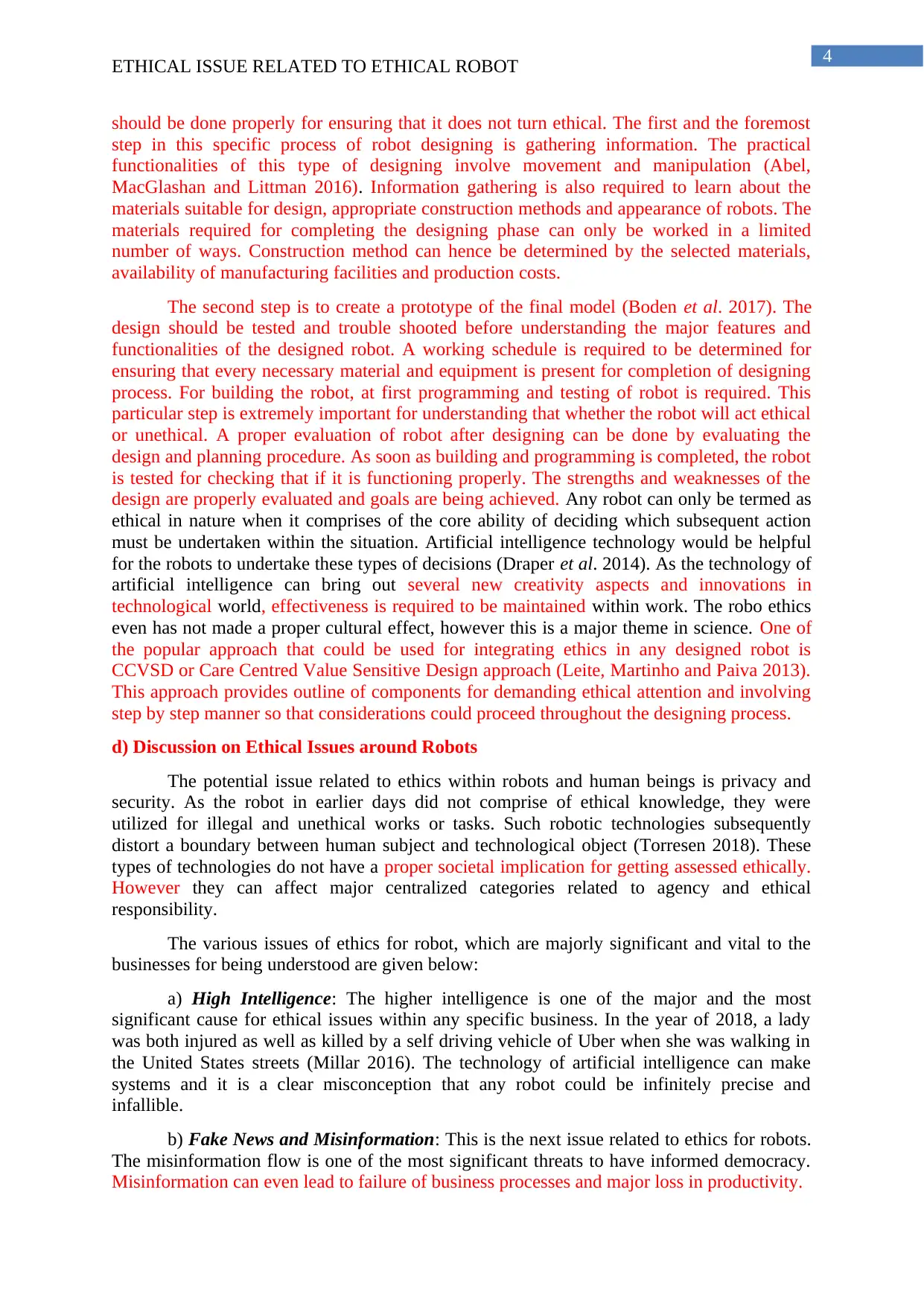
4
ETHICAL ISSUE RELATED TO ETHICAL ROBOT
should be done properly for ensuring that it does not turn ethical. The first and the foremost
step in this specific process of robot designing is gathering information. The practical
functionalities of this type of designing involve movement and manipulation (Abel,
MacGlashan and Littman 2016). Information gathering is also required to learn about the
materials suitable for design, appropriate construction methods and appearance of robots. The
materials required for completing the designing phase can only be worked in a limited
number of ways. Construction method can hence be determined by the selected materials,
availability of manufacturing facilities and production costs.
The second step is to create a prototype of the final model (Boden et al. 2017). The
design should be tested and trouble shooted before understanding the major features and
functionalities of the designed robot. A working schedule is required to be determined for
ensuring that every necessary material and equipment is present for completion of designing
process. For building the robot, at first programming and testing of robot is required. This
particular step is extremely important for understanding that whether the robot will act ethical
or unethical. A proper evaluation of robot after designing can be done by evaluating the
design and planning procedure. As soon as building and programming is completed, the robot
is tested for checking that if it is functioning properly. The strengths and weaknesses of the
design are properly evaluated and goals are being achieved. Any robot can only be termed as
ethical in nature when it comprises of the core ability of deciding which subsequent action
must be undertaken within the situation. Artificial intelligence technology would be helpful
for the robots to undertake these types of decisions (Draper et al. 2014). As the technology of
artificial intelligence can bring out several new creativity aspects and innovations in
technological world, effectiveness is required to be maintained within work. The robo ethics
even has not made a proper cultural effect, however this is a major theme in science. One of
the popular approach that could be used for integrating ethics in any designed robot is
CCVSD or Care Centred Value Sensitive Design approach (Leite, Martinho and Paiva 2013).
This approach provides outline of components for demanding ethical attention and involving
step by step manner so that considerations could proceed throughout the designing process.
d) Discussion on Ethical Issues around Robots
The potential issue related to ethics within robots and human beings is privacy and
security. As the robot in earlier days did not comprise of ethical knowledge, they were
utilized for illegal and unethical works or tasks. Such robotic technologies subsequently
distort a boundary between human subject and technological object (Torresen 2018). These
types of technologies do not have a proper societal implication for getting assessed ethically.
However they can affect major centralized categories related to agency and ethical
responsibility.
The various issues of ethics for robot, which are majorly significant and vital to the
businesses for being understood are given below:
a) High Intelligence: The higher intelligence is one of the major and the most
significant cause for ethical issues within any specific business. In the year of 2018, a lady
was both injured as well as killed by a self driving vehicle of Uber when she was walking in
the United States streets (Millar 2016). The technology of artificial intelligence can make
systems and it is a clear misconception that any robot could be infinitely precise and
infallible.
b) Fake News and Misinformation: This is the next issue related to ethics for robots.
The misinformation flow is one of the most significant threats to have informed democracy.
Misinformation can even lead to failure of business processes and major loss in productivity.
ETHICAL ISSUE RELATED TO ETHICAL ROBOT
should be done properly for ensuring that it does not turn ethical. The first and the foremost
step in this specific process of robot designing is gathering information. The practical
functionalities of this type of designing involve movement and manipulation (Abel,
MacGlashan and Littman 2016). Information gathering is also required to learn about the
materials suitable for design, appropriate construction methods and appearance of robots. The
materials required for completing the designing phase can only be worked in a limited
number of ways. Construction method can hence be determined by the selected materials,
availability of manufacturing facilities and production costs.
The second step is to create a prototype of the final model (Boden et al. 2017). The
design should be tested and trouble shooted before understanding the major features and
functionalities of the designed robot. A working schedule is required to be determined for
ensuring that every necessary material and equipment is present for completion of designing
process. For building the robot, at first programming and testing of robot is required. This
particular step is extremely important for understanding that whether the robot will act ethical
or unethical. A proper evaluation of robot after designing can be done by evaluating the
design and planning procedure. As soon as building and programming is completed, the robot
is tested for checking that if it is functioning properly. The strengths and weaknesses of the
design are properly evaluated and goals are being achieved. Any robot can only be termed as
ethical in nature when it comprises of the core ability of deciding which subsequent action
must be undertaken within the situation. Artificial intelligence technology would be helpful
for the robots to undertake these types of decisions (Draper et al. 2014). As the technology of
artificial intelligence can bring out several new creativity aspects and innovations in
technological world, effectiveness is required to be maintained within work. The robo ethics
even has not made a proper cultural effect, however this is a major theme in science. One of
the popular approach that could be used for integrating ethics in any designed robot is
CCVSD or Care Centred Value Sensitive Design approach (Leite, Martinho and Paiva 2013).
This approach provides outline of components for demanding ethical attention and involving
step by step manner so that considerations could proceed throughout the designing process.
d) Discussion on Ethical Issues around Robots
The potential issue related to ethics within robots and human beings is privacy and
security. As the robot in earlier days did not comprise of ethical knowledge, they were
utilized for illegal and unethical works or tasks. Such robotic technologies subsequently
distort a boundary between human subject and technological object (Torresen 2018). These
types of technologies do not have a proper societal implication for getting assessed ethically.
However they can affect major centralized categories related to agency and ethical
responsibility.
The various issues of ethics for robot, which are majorly significant and vital to the
businesses for being understood are given below:
a) High Intelligence: The higher intelligence is one of the major and the most
significant cause for ethical issues within any specific business. In the year of 2018, a lady
was both injured as well as killed by a self driving vehicle of Uber when she was walking in
the United States streets (Millar 2016). The technology of artificial intelligence can make
systems and it is a clear misconception that any robot could be infinitely precise and
infallible.
b) Fake News and Misinformation: This is the next issue related to ethics for robots.
The misinformation flow is one of the most significant threats to have informed democracy.
Misinformation can even lead to failure of business processes and major loss in productivity.
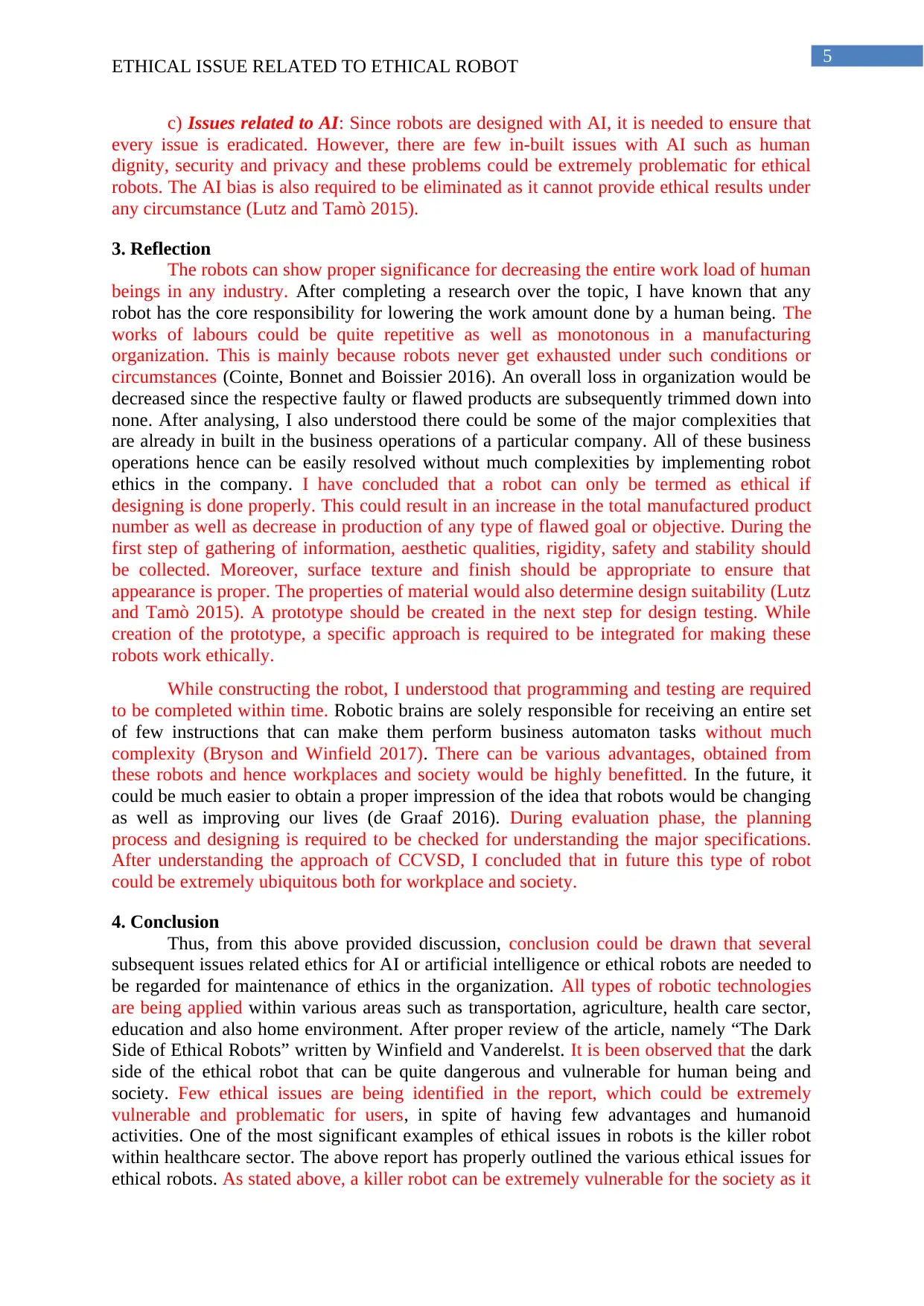
5
ETHICAL ISSUE RELATED TO ETHICAL ROBOT
c) Issues related to AI: Since robots are designed with AI, it is needed to ensure that
every issue is eradicated. However, there are few in-built issues with AI such as human
dignity, security and privacy and these problems could be extremely problematic for ethical
robots. The AI bias is also required to be eliminated as it cannot provide ethical results under
any circumstance (Lutz and Tamò 2015).
3. Reflection
The robots can show proper significance for decreasing the entire work load of human
beings in any industry. After completing a research over the topic, I have known that any
robot has the core responsibility for lowering the work amount done by a human being. The
works of labours could be quite repetitive as well as monotonous in a manufacturing
organization. This is mainly because robots never get exhausted under such conditions or
circumstances (Cointe, Bonnet and Boissier 2016). An overall loss in organization would be
decreased since the respective faulty or flawed products are subsequently trimmed down into
none. After analysing, I also understood there could be some of the major complexities that
are already in built in the business operations of a particular company. All of these business
operations hence can be easily resolved without much complexities by implementing robot
ethics in the company. I have concluded that a robot can only be termed as ethical if
designing is done properly. This could result in an increase in the total manufactured product
number as well as decrease in production of any type of flawed goal or objective. During the
first step of gathering of information, aesthetic qualities, rigidity, safety and stability should
be collected. Moreover, surface texture and finish should be appropriate to ensure that
appearance is proper. The properties of material would also determine design suitability (Lutz
and Tamò 2015). A prototype should be created in the next step for design testing. While
creation of the prototype, a specific approach is required to be integrated for making these
robots work ethically.
While constructing the robot, I understood that programming and testing are required
to be completed within time. Robotic brains are solely responsible for receiving an entire set
of few instructions that can make them perform business automaton tasks without much
complexity (Bryson and Winfield 2017). There can be various advantages, obtained from
these robots and hence workplaces and society would be highly benefitted. In the future, it
could be much easier to obtain a proper impression of the idea that robots would be changing
as well as improving our lives (de Graaf 2016). During evaluation phase, the planning
process and designing is required to be checked for understanding the major specifications.
After understanding the approach of CCVSD, I concluded that in future this type of robot
could be extremely ubiquitous both for workplace and society.
4. Conclusion
Thus, from this above provided discussion, conclusion could be drawn that several
subsequent issues related ethics for AI or artificial intelligence or ethical robots are needed to
be regarded for maintenance of ethics in the organization. All types of robotic technologies
are being applied within various areas such as transportation, agriculture, health care sector,
education and also home environment. After proper review of the article, namely “The Dark
Side of Ethical Robots” written by Winfield and Vanderelst. It is been observed that the dark
side of the ethical robot that can be quite dangerous and vulnerable for human being and
society. Few ethical issues are being identified in the report, which could be extremely
vulnerable and problematic for users, in spite of having few advantages and humanoid
activities. One of the most significant examples of ethical issues in robots is the killer robot
within healthcare sector. The above report has properly outlined the various ethical issues for
ethical robots. As stated above, a killer robot can be extremely vulnerable for the society as it
ETHICAL ISSUE RELATED TO ETHICAL ROBOT
c) Issues related to AI: Since robots are designed with AI, it is needed to ensure that
every issue is eradicated. However, there are few in-built issues with AI such as human
dignity, security and privacy and these problems could be extremely problematic for ethical
robots. The AI bias is also required to be eliminated as it cannot provide ethical results under
any circumstance (Lutz and Tamò 2015).
3. Reflection
The robots can show proper significance for decreasing the entire work load of human
beings in any industry. After completing a research over the topic, I have known that any
robot has the core responsibility for lowering the work amount done by a human being. The
works of labours could be quite repetitive as well as monotonous in a manufacturing
organization. This is mainly because robots never get exhausted under such conditions or
circumstances (Cointe, Bonnet and Boissier 2016). An overall loss in organization would be
decreased since the respective faulty or flawed products are subsequently trimmed down into
none. After analysing, I also understood there could be some of the major complexities that
are already in built in the business operations of a particular company. All of these business
operations hence can be easily resolved without much complexities by implementing robot
ethics in the company. I have concluded that a robot can only be termed as ethical if
designing is done properly. This could result in an increase in the total manufactured product
number as well as decrease in production of any type of flawed goal or objective. During the
first step of gathering of information, aesthetic qualities, rigidity, safety and stability should
be collected. Moreover, surface texture and finish should be appropriate to ensure that
appearance is proper. The properties of material would also determine design suitability (Lutz
and Tamò 2015). A prototype should be created in the next step for design testing. While
creation of the prototype, a specific approach is required to be integrated for making these
robots work ethically.
While constructing the robot, I understood that programming and testing are required
to be completed within time. Robotic brains are solely responsible for receiving an entire set
of few instructions that can make them perform business automaton tasks without much
complexity (Bryson and Winfield 2017). There can be various advantages, obtained from
these robots and hence workplaces and society would be highly benefitted. In the future, it
could be much easier to obtain a proper impression of the idea that robots would be changing
as well as improving our lives (de Graaf 2016). During evaluation phase, the planning
process and designing is required to be checked for understanding the major specifications.
After understanding the approach of CCVSD, I concluded that in future this type of robot
could be extremely ubiquitous both for workplace and society.
4. Conclusion
Thus, from this above provided discussion, conclusion could be drawn that several
subsequent issues related ethics for AI or artificial intelligence or ethical robots are needed to
be regarded for maintenance of ethics in the organization. All types of robotic technologies
are being applied within various areas such as transportation, agriculture, health care sector,
education and also home environment. After proper review of the article, namely “The Dark
Side of Ethical Robots” written by Winfield and Vanderelst. It is been observed that the dark
side of the ethical robot that can be quite dangerous and vulnerable for human being and
society. Few ethical issues are being identified in the report, which could be extremely
vulnerable and problematic for users, in spite of having few advantages and humanoid
activities. One of the most significant examples of ethical issues in robots is the killer robot
within healthcare sector. The above report has properly outlined the various ethical issues for
ethical robots. As stated above, a killer robot can be extremely vulnerable for the society as it
⊘ This is a preview!⊘
Do you want full access?
Subscribe today to unlock all pages.

Trusted by 1+ million students worldwide

6
ETHICAL ISSUE RELATED TO ETHICAL ROBOT
does not have the knowledge of wrong and right. In this report, a significant personal
reflection for a statement that robot can be ubiquitous within society and work place. After
completing the review as well as reflection, it is concluded that robots can be referred to as
ethical within future by implementation of few methodologies and sensors to remove the
issues related to ethics.
ETHICAL ISSUE RELATED TO ETHICAL ROBOT
does not have the knowledge of wrong and right. In this report, a significant personal
reflection for a statement that robot can be ubiquitous within society and work place. After
completing the review as well as reflection, it is concluded that robots can be referred to as
ethical within future by implementation of few methodologies and sensors to remove the
issues related to ethics.
Paraphrase This Document
Need a fresh take? Get an instant paraphrase of this document with our AI Paraphraser
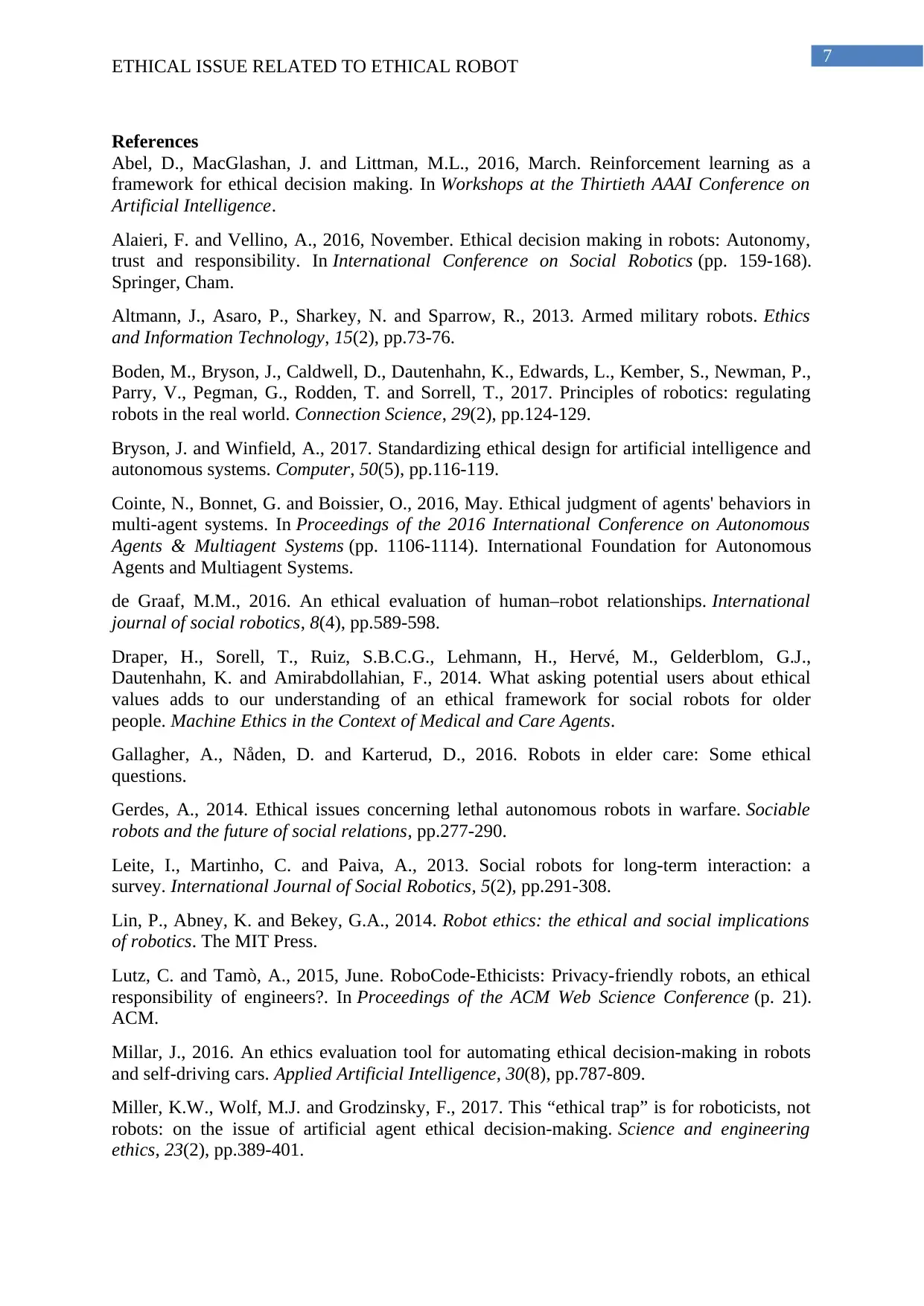
7
ETHICAL ISSUE RELATED TO ETHICAL ROBOT
References
Abel, D., MacGlashan, J. and Littman, M.L., 2016, March. Reinforcement learning as a
framework for ethical decision making. In Workshops at the Thirtieth AAAI Conference on
Artificial Intelligence.
Alaieri, F. and Vellino, A., 2016, November. Ethical decision making in robots: Autonomy,
trust and responsibility. In International Conference on Social Robotics (pp. 159-168).
Springer, Cham.
Altmann, J., Asaro, P., Sharkey, N. and Sparrow, R., 2013. Armed military robots. Ethics
and Information Technology, 15(2), pp.73-76.
Boden, M., Bryson, J., Caldwell, D., Dautenhahn, K., Edwards, L., Kember, S., Newman, P.,
Parry, V., Pegman, G., Rodden, T. and Sorrell, T., 2017. Principles of robotics: regulating
robots in the real world. Connection Science, 29(2), pp.124-129.
Bryson, J. and Winfield, A., 2017. Standardizing ethical design for artificial intelligence and
autonomous systems. Computer, 50(5), pp.116-119.
Cointe, N., Bonnet, G. and Boissier, O., 2016, May. Ethical judgment of agents' behaviors in
multi-agent systems. In Proceedings of the 2016 International Conference on Autonomous
Agents & Multiagent Systems (pp. 1106-1114). International Foundation for Autonomous
Agents and Multiagent Systems.
de Graaf, M.M., 2016. An ethical evaluation of human–robot relationships. International
journal of social robotics, 8(4), pp.589-598.
Draper, H., Sorell, T., Ruiz, S.B.C.G., Lehmann, H., Hervé, M., Gelderblom, G.J.,
Dautenhahn, K. and Amirabdollahian, F., 2014. What asking potential users about ethical
values adds to our understanding of an ethical framework for social robots for older
people. Machine Ethics in the Context of Medical and Care Agents.
Gallagher, A., Nåden, D. and Karterud, D., 2016. Robots in elder care: Some ethical
questions.
Gerdes, A., 2014. Ethical issues concerning lethal autonomous robots in warfare. Sociable
robots and the future of social relations, pp.277-290.
Leite, I., Martinho, C. and Paiva, A., 2013. Social robots for long-term interaction: a
survey. International Journal of Social Robotics, 5(2), pp.291-308.
Lin, P., Abney, K. and Bekey, G.A., 2014. Robot ethics: the ethical and social implications
of robotics. The MIT Press.
Lutz, C. and Tamò, A., 2015, June. RoboCode-Ethicists: Privacy-friendly robots, an ethical
responsibility of engineers?. In Proceedings of the ACM Web Science Conference (p. 21).
ACM.
Millar, J., 2016. An ethics evaluation tool for automating ethical decision-making in robots
and self-driving cars. Applied Artificial Intelligence, 30(8), pp.787-809.
Miller, K.W., Wolf, M.J. and Grodzinsky, F., 2017. This “ethical trap” is for roboticists, not
robots: on the issue of artificial agent ethical decision-making. Science and engineering
ethics, 23(2), pp.389-401.
ETHICAL ISSUE RELATED TO ETHICAL ROBOT
References
Abel, D., MacGlashan, J. and Littman, M.L., 2016, March. Reinforcement learning as a
framework for ethical decision making. In Workshops at the Thirtieth AAAI Conference on
Artificial Intelligence.
Alaieri, F. and Vellino, A., 2016, November. Ethical decision making in robots: Autonomy,
trust and responsibility. In International Conference on Social Robotics (pp. 159-168).
Springer, Cham.
Altmann, J., Asaro, P., Sharkey, N. and Sparrow, R., 2013. Armed military robots. Ethics
and Information Technology, 15(2), pp.73-76.
Boden, M., Bryson, J., Caldwell, D., Dautenhahn, K., Edwards, L., Kember, S., Newman, P.,
Parry, V., Pegman, G., Rodden, T. and Sorrell, T., 2017. Principles of robotics: regulating
robots in the real world. Connection Science, 29(2), pp.124-129.
Bryson, J. and Winfield, A., 2017. Standardizing ethical design for artificial intelligence and
autonomous systems. Computer, 50(5), pp.116-119.
Cointe, N., Bonnet, G. and Boissier, O., 2016, May. Ethical judgment of agents' behaviors in
multi-agent systems. In Proceedings of the 2016 International Conference on Autonomous
Agents & Multiagent Systems (pp. 1106-1114). International Foundation for Autonomous
Agents and Multiagent Systems.
de Graaf, M.M., 2016. An ethical evaluation of human–robot relationships. International
journal of social robotics, 8(4), pp.589-598.
Draper, H., Sorell, T., Ruiz, S.B.C.G., Lehmann, H., Hervé, M., Gelderblom, G.J.,
Dautenhahn, K. and Amirabdollahian, F., 2014. What asking potential users about ethical
values adds to our understanding of an ethical framework for social robots for older
people. Machine Ethics in the Context of Medical and Care Agents.
Gallagher, A., Nåden, D. and Karterud, D., 2016. Robots in elder care: Some ethical
questions.
Gerdes, A., 2014. Ethical issues concerning lethal autonomous robots in warfare. Sociable
robots and the future of social relations, pp.277-290.
Leite, I., Martinho, C. and Paiva, A., 2013. Social robots for long-term interaction: a
survey. International Journal of Social Robotics, 5(2), pp.291-308.
Lin, P., Abney, K. and Bekey, G.A., 2014. Robot ethics: the ethical and social implications
of robotics. The MIT Press.
Lutz, C. and Tamò, A., 2015, June. RoboCode-Ethicists: Privacy-friendly robots, an ethical
responsibility of engineers?. In Proceedings of the ACM Web Science Conference (p. 21).
ACM.
Millar, J., 2016. An ethics evaluation tool for automating ethical decision-making in robots
and self-driving cars. Applied Artificial Intelligence, 30(8), pp.787-809.
Miller, K.W., Wolf, M.J. and Grodzinsky, F., 2017. This “ethical trap” is for roboticists, not
robots: on the issue of artificial agent ethical decision-making. Science and engineering
ethics, 23(2), pp.389-401.
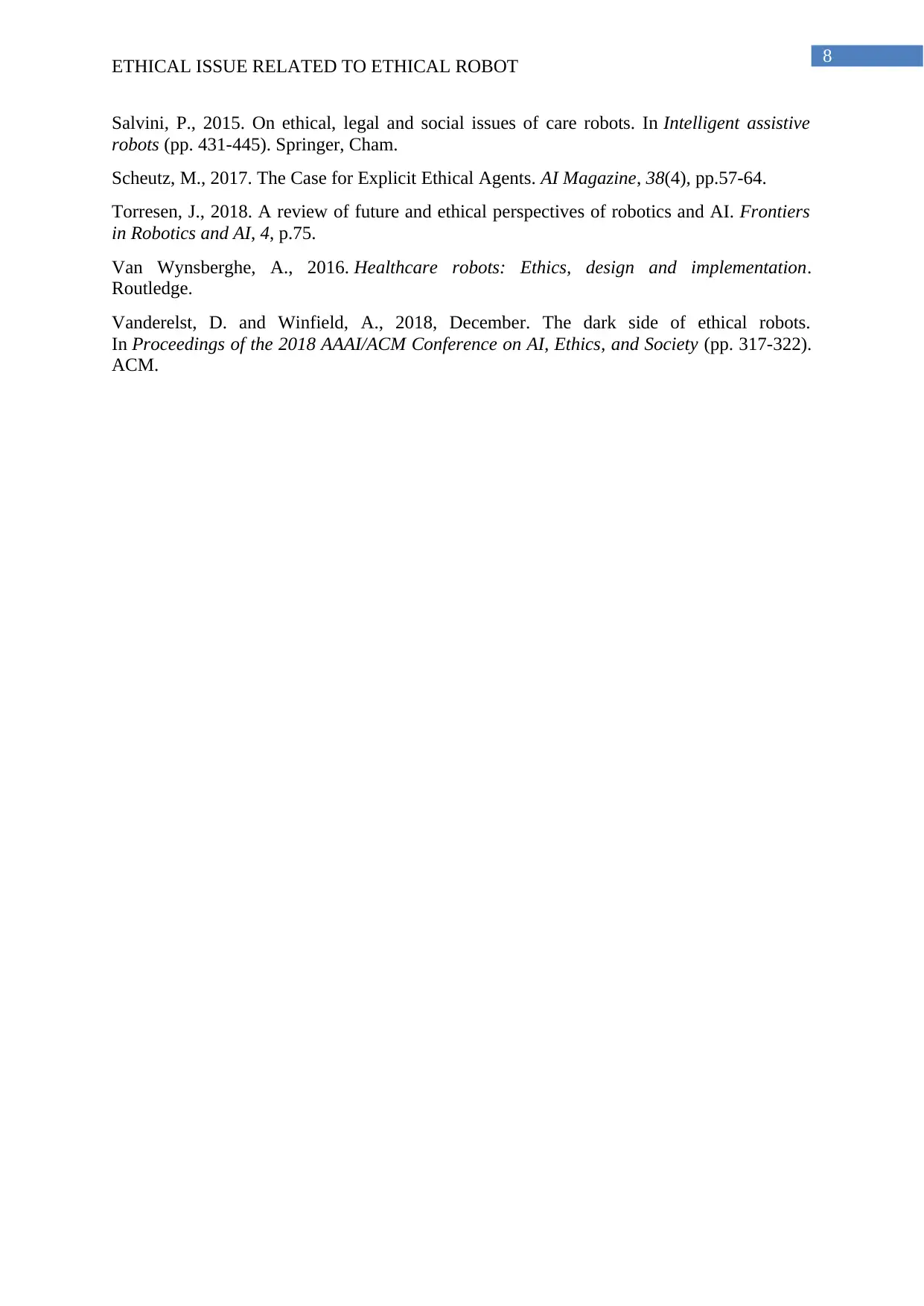
8
ETHICAL ISSUE RELATED TO ETHICAL ROBOT
Salvini, P., 2015. On ethical, legal and social issues of care robots. In Intelligent assistive
robots (pp. 431-445). Springer, Cham.
Scheutz, M., 2017. The Case for Explicit Ethical Agents. AI Magazine, 38(4), pp.57-64.
Torresen, J., 2018. A review of future and ethical perspectives of robotics and AI. Frontiers
in Robotics and AI, 4, p.75.
Van Wynsberghe, A., 2016. Healthcare robots: Ethics, design and implementation.
Routledge.
Vanderelst, D. and Winfield, A., 2018, December. The dark side of ethical robots.
In Proceedings of the 2018 AAAI/ACM Conference on AI, Ethics, and Society (pp. 317-322).
ACM.
ETHICAL ISSUE RELATED TO ETHICAL ROBOT
Salvini, P., 2015. On ethical, legal and social issues of care robots. In Intelligent assistive
robots (pp. 431-445). Springer, Cham.
Scheutz, M., 2017. The Case for Explicit Ethical Agents. AI Magazine, 38(4), pp.57-64.
Torresen, J., 2018. A review of future and ethical perspectives of robotics and AI. Frontiers
in Robotics and AI, 4, p.75.
Van Wynsberghe, A., 2016. Healthcare robots: Ethics, design and implementation.
Routledge.
Vanderelst, D. and Winfield, A., 2018, December. The dark side of ethical robots.
In Proceedings of the 2018 AAAI/ACM Conference on AI, Ethics, and Society (pp. 317-322).
ACM.
⊘ This is a preview!⊘
Do you want full access?
Subscribe today to unlock all pages.

Trusted by 1+ million students worldwide
1 out of 9
Related Documents
Your All-in-One AI-Powered Toolkit for Academic Success.
+13062052269
info@desklib.com
Available 24*7 on WhatsApp / Email
![[object Object]](/_next/static/media/star-bottom.7253800d.svg)
Unlock your academic potential
Copyright © 2020–2025 A2Z Services. All Rights Reserved. Developed and managed by ZUCOL.





